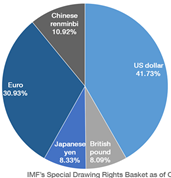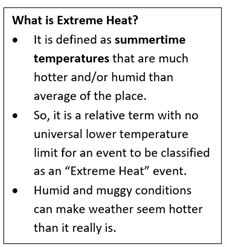Thursday, 26th August 2021
Movement of women from informal to formal sector
In News
A recent survey by the Institute for Human Development has found that 20% of women moved from informal to formal sector between 2010 and 2019.
Findings of the Survey
- Inter-sector movement: Women moved out from construction labour, domestic work and vending and moved into sales workers, tuition or teaching, beautician and helper or assistant in offices and factories.
- Factors of mobility from informal to formal sectors
- Educational qualifications: Graduates have 3.5 times higher probability than unlettered
- Experience
- Belonging to higher income groups, upper caste, and non-migrants
- Challenges faced by the informal sector workers: Among the challenges faced by the workers in the informal sector are poor working conditions, long working hours, lack of safety or security, lack of credit facility and space to work and changing technologies. The study says only our out of 10 women were aware of various welfare schemes of the government.
Recommendations of the Study
- Create a national database of informal workers with regular updating
- Assist workers with documentation to link them with existing social security and welfare schemes.
- Provide workspace to small vendors and protect them from harassment by authorities.
- Recognise domestic workers and regulate their payment and working conditions.
- Provide skill training to unskilled workers.
- Provide a start kit and initial financial support and assist in market linkages to the trained workers interested in entrepreneurship.
Benefits of formal employment to women
- Maternity leave under the Maternity Benefits Act, 1961.
- Provides Social Security, equal pay for equal work, job security and occupational health safeguards under the 4 Labour Codes.
- Protected under the Sexual Harassment of Women at Workplace (Prevention, Prohibition and Redressal) Act, 2013.
Source:
Forum for Decarbonizing Transport in India
In News
NITI Aayog, in collaboration with World Resources Institute (WRI), launched the Forum for Decarbonising Transport.
About Forum for Decarbonising Transport
- Aim: The project aims at bringing down the peak level of GHG emissions (transport sector) in Asia (in line with a well below 2-degree pathway), resulting in problems like congestion and air pollution.
- Strategies: The project focuses on developing a coherent strategy of effective policies and the formation of a multi-stakeholder platform for decarbonising transport in the region. The Forum for Decorbonising of Transport will act as the conduit for bringing diverse voices and needs to adopt an integrated approach for greening the transport sector in India.
- Collaborations: The forum is a part of the Nationally Determined Contribution -Transport Initiative for Asia (NDC-TIA 2020-2023) project.
- It is a joint programme of seven organizations that will engage China, India, and Vietnam with an objective to facilitate a paradigm shift to zero emission transport across Asia.
- The project is part of the International Climate Initiative (IKI) and NITI Aayog is the implementing partner for India.
- Participative development: Through this forum, the NITI Aayog and other project partners, will work in close coordination with all the stakeholders to develop appropriate and innovative business models and uniform policies to reduce carbon emissions and accelerate holistic growth of electric mobility in India thereby greening the transport sector.
Other Initiatives in Transport sector in India
- Need: India has a massive and diverse transport sector, which is also the third most CO2 emitting sector.
- Within the transport sector, road transport contributes to more than 90% of the total CO2 emissions.
- Electric Mobility: Electric vehicles and sustainable mobility is being promoted through the National Mission on Transformative Mobility and Battery Storage.
- FAME India Scheme that encourages faster adoption of electric and hybrid vehicles by way of offering upfront Incentive on purchase of Electric vehicles.
- PLI Scheme: The Indian government had rolled out a production-linked incentive (PLI) scheme for various industries including the automobile and auto-component industry.
- Fuel Efficiency: Around ₹18,000 crore was approved for development of advanced cell chemistry battery storage manufacturing. India has also set a target of 20% Ethanol Blending by 2025.
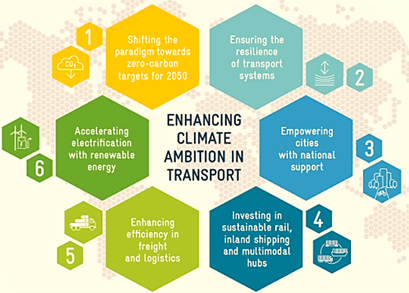
Source:
-
NITI Aayog, WRI launch forum for decarbonisation of transport sector
- NITI Aayog and World Resources Institute India Jointly Launch ‘Forum for Decarbonizing Transport’ in India
Image Source
EASE 4.0
In News
Ministry of Finance has unveiled the Public Sector Bank (PSB) Reforms Agenda ‘EASE 4.0’ for 2021-22 for tech-enabled, simplified, and collaborative banking.
About the News
- EASE 4.0 has been introduced in the backdrop of the successful implementation of EASE 3.0 and the amalgamation of 13 PSBs into 5 PSBs.
- EASE 4.0 commits PSBs to tech-enabled, simplified and collaborative banking and aims to further the agenda of customer-centric digital transformation and deeply embed digital and data into PSBs’ ways of working.
About EASE 4.0

What are EASE reforms?
- Participation: EASE Reforms were launched in January 2018 jointly by the government and PSBs.
- Aim: EASE Reforms aim at institutionalizing clean and smart banking.
- Measurement: EASE index measures the performance of each PSB on 120 objective metrics.
- EASE 1.0 reported improvement in PSB performance in resolution of Non-Performing Assets (NPAs).
- EASE 2.0 aimed at making the reforms journey irreversible and strengthen the process and the outcome.
- EASE 3.0 aimed at adopting smart and tech enabled banking.
Sources:
Image Source:
Solid Waste Management
In News
Parts of Bhalswa landfill collapsed onto nearby homes due to destabilisation of the landfill.
About the News
- In a similar incident, parts of the dump site at Bhalswa, Delhi’s second largest landfill had collapsed in 2017, killing two people and injuring five.
- Mumbai and Delhi are the country’s top two metro cities when it comes to solid waste generated per day. Together, it is estimated, they generate nearly as much waste as the next eight metro cities on the list.
What is Solid Waste Management?
- Solid waste management refers to the process of collecting and treating solid wastes.
- It also offers solutions for recycling items that do not belong to garbage or trash.
- Solid waste management practices can differ for residential and industrial producers, for urban and rural areas, and for developed and developing
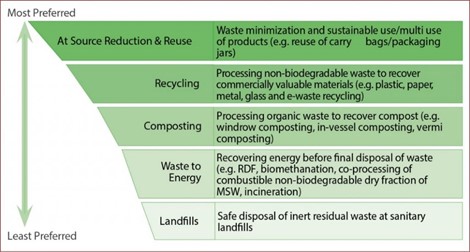
Need for Solid Waste Management
- Rising Waste Generation: Around the world, waste generation rates are rising. With rapid population growth and urbanization, annual waste generation is expected to increase by 70% from 2016 levels to 3.40 billion tonnes in 2050.
- Adverse climatic impacts of Waste: Poorly managed waste serves as a breeding ground for disease vectors, contributes to global climate change through methane generation, and can even promote urban violence.
- Rising Landfills: Most dumpsites are two to three decades old and currently receive 2,000 (Bhalswa) to 9,000 (Deonar) metric ton of solid waste daily. Only a few areas on large landfills have new and advanced waste management technology (like waste-to-energy, composting and refuse-derived fuel systems).
- Groundwater sampling in these locations indicate high levels of toxic contaminants rendering the water highly dangerous to use. People near these sites suffer from chronic and acute health issues, with high incidence of tuberculosis, asthma and gastrointestinal disorders.
Solid waste Management in India
- Current Status: With rapid urbanisation, the country is facing massive waste management challenge. Of the approximately 90 percent waste collected, only 20 percent of it is processed and the remaining 80 percent goes to the dump sites.
- Government Rules and Policies for SWM in India
- Solid Waste Management Rules, 2016: These rules provide for waste generators to segregate waste at source and allocate dry waste such as GS Paper, plastic, glass and metal for recycling and reuse, as well as utilise wet waste from the kitchen for composting or biomethanation.
- Plastic Waste Management Rules, 2016: The responsibility of waste generators is to segregate and store the plastic waste generated in accordance with the SWM Rules of 2016 before handing it over to an authorised waste collection agency.
- Municipal Solid Waste Management Manual, 2016: The Manual provides guidance to ULBs on planning, design, implementation and monitoring of MSWM systems.
- Swachh Bharat Mission (Urban): The SBM addresses the growing problems of open defecation, sanitation, and SWM. It seeks people’s participation in creating a trash-free environment, providing sanitation facilities and paving a way for Swachh Bharat.
The key challenges in the context of SWM in India
- Lack of Data: Data on the quantum of waste generation in India is conflicting, since there is no system of periodic data collection on waste generation. Consequently, the estimations and projections of solid waste vary wildly from one agency to the other.
- Inefficient Collection: Research has shown that waste collection efficiency is low in India, due to non-uniformity in the collection system.
- Waste Dumping: Most cities and towns in India dispose of their waste by depositing it in low-lying areas outside the city, without taking adequate precautions.
- Expensive Affair: Effective waste management is expensive, often comprising 20%–50% of municipal budgets. Being heavily dependent on the state governments for funding, these local bodies lack the resources to acquire new land or obtain the technologies required for SWM.
- Issues with Waste to Energy (WtE): WtE is a widely used technology in India, but it faces several problems, including unsegregated waste and seasonal variation in waste composition. Most WtE plants cannot function effectively due to operational and design issues.
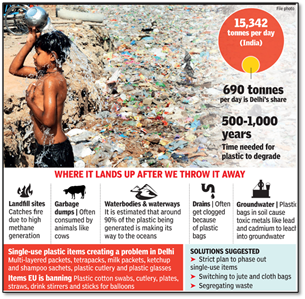
Way Forward
- Re-invent SWM: Around 100 cities are set to be developed as smart cities. Civic bodies have to redraw long term vision in solid waste management and rework their strategies as per changing lifestyles.
- Cities like Bengaluru to Alappuzha are slowly shifting to decentralized solid waste management approaches with household and community level waste segregation and resource recovery solutions being implemented successfully.
- Adequate funding: For the situation to improve, institutional and financial issues must be addressed on priority. While the 2016 SWM Rules do address a significant number of issues, compliance remains weak. A policy GS Paper or action plan must be prepared to promote the decentralisation of the waste management system.
- Citizen Participation: To enhance the efficiency of SWM in India, citizen participation should be promoted, especially in source segregation and treatment processes. The policy agenda for sustainable SWM must drive behavioural change amongst citizens, elected representatives and decision-makers, to minimise wastage and littering, and increase reuse and recycling.
Question: Discuss the status solid waste management in India and challenges associated with it. What are the steps needed to improve SWM in India?
Sources:
This Day in History - Mother Teresa
On August 26, 1910, Mother Teresa was born in Skopje, the current capital of the Republic of Macedonia. Nun and missionary Mother Teresa, known in the Catholic church as Saint Teresa of Calcutta, devoted her life to caring for the sick and poor. In 1979, Mother Teresa received the Nobel Peace Prize for her humanitarian work. Mother Teresa was the founder of the Order of the Missionaries of Charity, a Roman Catholic congregation of women dedicated to helping the poor and is considered to be one of the 20th Century's greatest humanitarians.

Source:
Image of the Day - ATLAS
This is the image of comet ATLAS, taken by the Hubble Space Telescope, revealing the breakup of the solid nucleus of the comet. Comet ATLAS, first detected by the Asteroid Terrestrial-impact Last Alert System (ATLAS), operated by the University of Hawaii, quickly met an untimely death in mid-2020 when it disintegrated into a cascade of small icy pieces. A new study reports that ATLAS is a broken-off piece of that ancient visitor from 5,000 years ago.

Source:
SAMARTH Udyog Bharat 4.0
- Context: Central Manufacturing Technology Institute (CMTI) Bangalore, has organized a webinar under the SAMARTH Udyog Bharat 4.0 Platform to celebrate the Azadi ka Amrit Mahotsav.
- Smart Advanced Manufacturing and Rapid Transformation Hub(SAMARTH) Udyog Bharat 4.0 is an Industry 4.0 initiative of Department of Heavy Industry, Ministry of Heavy Industry & Public Enterprises.
- It falls under Government of India’s scheme on enhancement of competitiveness in Indian capital goods sector.
- SAMARTH Udyog encompasses manufacturers, vendors, and customers as the main stakeholders.
- Industry 4.0refers to the fourth industrial revolution, which is the cyber-physical transformation of manufacturing.
- It will incorporate trends of automation and data exchange in manufacturing technologies, including cyber-physical systems, the Internet of things, cloud computing, cognitive computing and create smart factory.
Source:
e-Shram portal
- Context: The government will be launching the e-Shram portal, a database of unorganized sector workers.
- e-Shram portal is the national database for ‘Shram Yogis’ (unorganized workers) to bring them on a common platform to help take welfare schemes to their doorstep and to plug the gaps in targeted and last-mile delivery.
- The database will include construction workers, migrant workers, gig and platform workers, street vendors, domestic workers, agriculture workers, etc.
- A worker can register on the portal using his/her Aadhaar card number and bank account details, apart from filling other necessary details like date of birth, hometown, mobile number and social category.
- Following the registration, workers will be issued an e-Shram card containing a 12-digit unique number which will help in including them in social security schemes.
- It is an initiative of Ministry of Labour & Employment.
Source:
Global Manufacturing Risk Index 2021
- Context: India has become thesecond-most sought-after manufacturing destination globally in the Global Manufacturing Risk Index 2021.
- Global Manufacturing Risk Index assesses the most advantageous locations for global manufacturing among 47 countries in Europe, the Americas and Asia-Pacific (APAC).
- The index is published by US-based consultant Cushman & Wakefield.
- The rankings in the report are determined based on four key parameters that include:
- Country’s capability to restart manufacturing
- Business environment (availability of talent/labour, access to markets)
- Operating costs and
- Risks (political, economic and environmental)
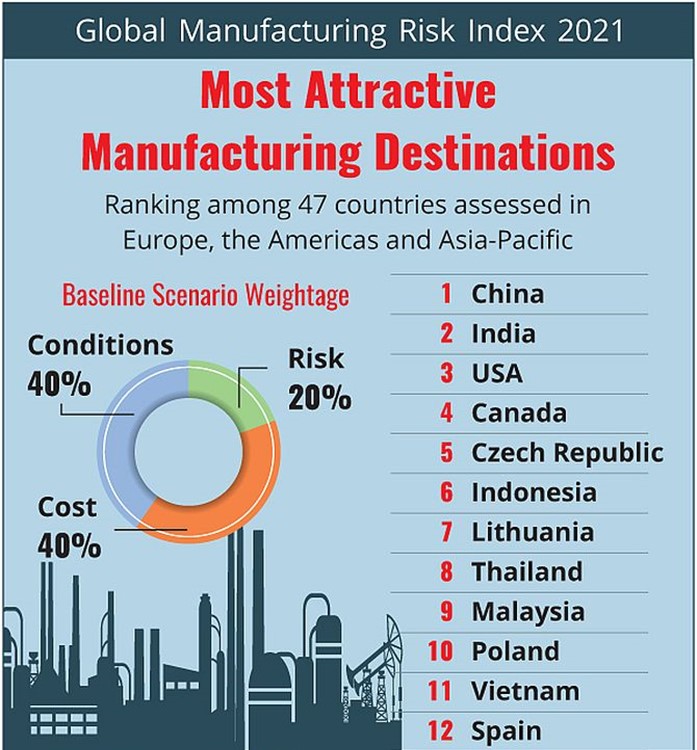
Source:
- India pips US to rank second in list of most attractive manufacturing hub globally; China first
- India Pips US to Become Second Most Attractive Manufacturing Hub; China on Top
Image source:
Predator Drone Deal
- Context: India has sought more clarity from the US on the price fixation, maintenance, and transfer of technology in the proposed $3bn deal on predator drones.
- The armed MQ-9B Predator drones are designed for long-range precision strikes against hostile targets on land and sea.
- The Indian Armed Forces have for long been looking to induct such fighter sized “hunter-killer” drones armed with air-to-ground missiles and smart bombs as well as capable of flying for almost 40 hours at a stretch to boost their long range unmanned lethal capabilities
- India had finalized the plan to acquire the 30 MQ-9B or Sea Guardian/Sky Guardian remotely piloted aircraft systems (RPAS), 10 each for the Army, Navy and the IAF with different payloads to hunt and destroy targets on land and sea.

Sources:
- $3bn Predator Drone Deal: India seeks clarity from US on price, tech transfer
- India seeks more information on $3 billion drone acquisition before it seals the deal with US
Image source:
Negotiating the new global climate policy- TH
Essence: The article talks about the significance of the recent report of the UN Intergovernmental Panel on Climate Change. The cumulative emissions up to net-zero determine the reach of the temperature and importance of the incompetency of a global policy that is directed only towards current emissions because that will not limit the adverse effects of global warming. The article talks about the G20 summit which happened in July where India mentioned that major economies across the world have to bring down their per capita emission to the global average by 2030. India pointed out that the Objective of the Climate Treaty is all about stabilization of greenhouse gas concentrations and climate justice.
Why should you read this article?
- To understand the importance of climate change and factors related to it.
- To understand India’s perspective and suggestions on climate change given at UN Intergovernmental Panel on Climate Change.
Source:
Helping and hindering justice- TH
Essence: Due to COVID- 19 pandemic, the courts’ efforts to rise up to the challenges of delivering justice with existing technology has proved to be an uphill task. Reasons being, inadequate digital literacy across the country, inadequate digital penetration, and serious issues of bandwidth and connectivity, particularly in remote and inaccessible regions. This results in all-time high pendency of cases which can be tackled by addressing uneven digital access with adequate data-based planning and safeguards.
Why should you read this article?
- To know how COVID 19 pandemic is posing challenge to Indian Judicial systems.
- To understand why relying solely on digital transformation may not be a sound idea.
- To know what steps should be taken to tackle the issue.
Source:
Don’t chase the mirage of iron-fortified rice- IE
Essence: It is an accepted fact among the policy makers that a vast majority of women and children in India are iron deficient. Corrective steps taken by the government like food fortification and iron tablets point towards the fact that policy makers believe in technological solutions to this problem.
Relying on the latest research, authors suggest that percentage of anaemic individuals in India are highly inflated. At the same time, the article also questions the utility of technological solutions which in addition to being costly can also have adverse effects on health.
It is suggested that by eating a diverse diet (with fruits and vegetables), and improving our environment, we will go a long way in addressing iron deficiency.
Why should you read the article?
- To appreciate the importance of aligning policy with latest research outcomes.
- To understand that technology is not a panacea.
- To know about steps that can be taken to address problem related to malnutrition in India.
Source:
Climate Sensitisation via Education
Background
- Despite the global warming, climate change and pollution, schools in the country have not been able to sensitise children towards the environmental issues.
- Swapnopuron Shiksha Niketan School in Bengal has introduced environmental pedagogy to make children sensitive to the needs of the environment.
Need
- Problem solving: Environmental education as part of the curriculum is needed to fight the climate issues.
- Ownership: Children must acknowledge that it is their land, and they must learn how to save it.
- Awareness: Children have limited understanding of how climate change is linked to these extreme weather events, hence awareness generation is at the heart of the programme.
Outcome
- Responsible citizens: Children of today are citizens of tomorrow. Such a model can create responsible citizen who focusses on responsible consumerism.
- Sustainable Development: This education model can help achieve the target of SDG and make earth a better place to live.
Quote:
- “The Earth is what we all have in common.”-Wendell Berry.
Source:
Share the article
Get Latest Updates on Offers, Event dates, and free Mentorship sessions.

Get in touch with our Expert Academic Counsellors 👋
FAQs
UPSC Daily Current Affairs focuses on learning current events on a daily basis. An aspirant needs to study regular and updated information about current events, news, and relevant topics that are important for UPSC aspirants. It covers national and international affairs, government policies, socio-economic issues, science and technology advancements, and more.
UPSC Daily Current Affairs provides aspirants with a concise and comprehensive overview of the latest happenings and developments across various fields. It helps aspirants stay updated with current affairs and provides them with valuable insights and analysis, which are essential for answering questions in the UPSC examinations. It enhances their knowledge, analytical skills, and ability to connect current affairs with the UPSC syllabus.
UPSC Daily Current Affairs covers a wide range of topics, including politics, economics, science and technology, environment, social issues, governance, international relations, and more. It offers news summaries, in-depth analyses, editorials, opinion pieces, and relevant study materials. It also provides practice questions and quizzes to help aspirants test their understanding of current affairs.
Edukemy's UPSC Daily Current Affairs can be accessed through:
- UPSC Daily Current Affairs can be accessed through Current Affairs tab at the top of the Main Page of Edukemy.
- Edukemy Mobile app: The Daily Current Affairs can also be access through Edukemy Mobile App.
- Social media: Follow Edukemy’s official social media accounts or pages that provide UPSC Daily Current Affairs updates, including Facebook, Twitter, or Telegram channels.

